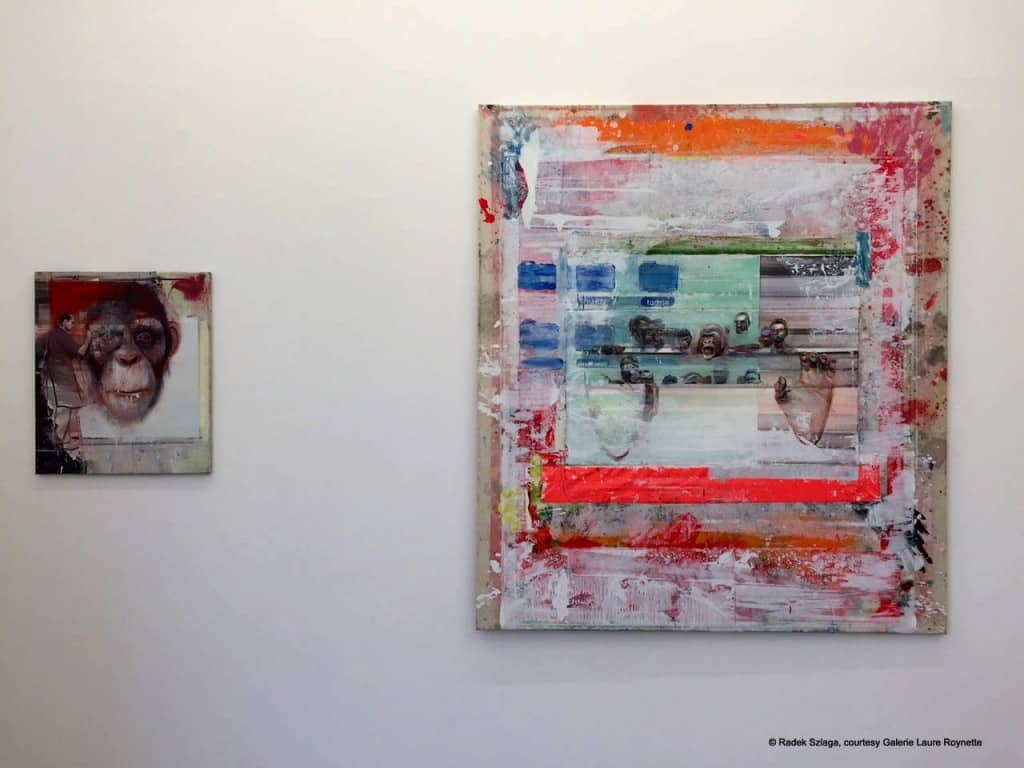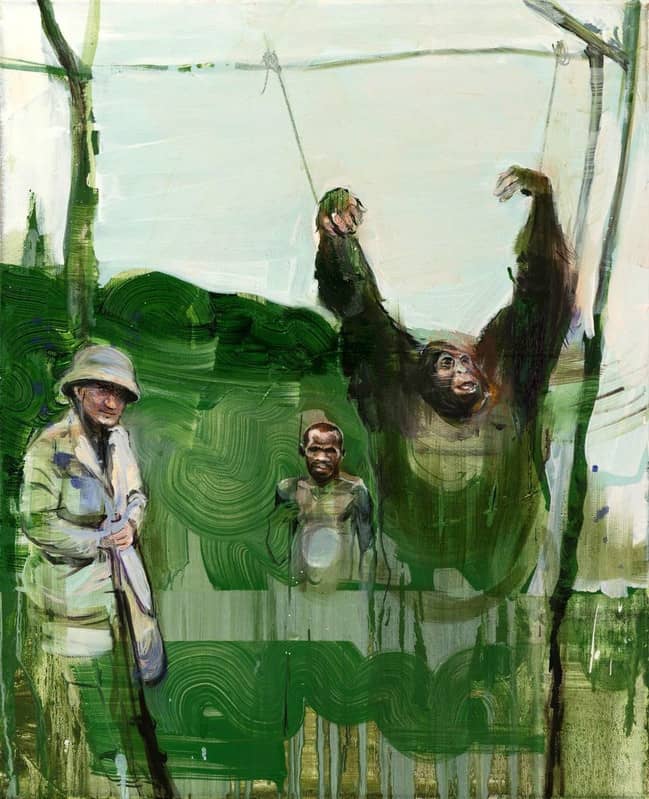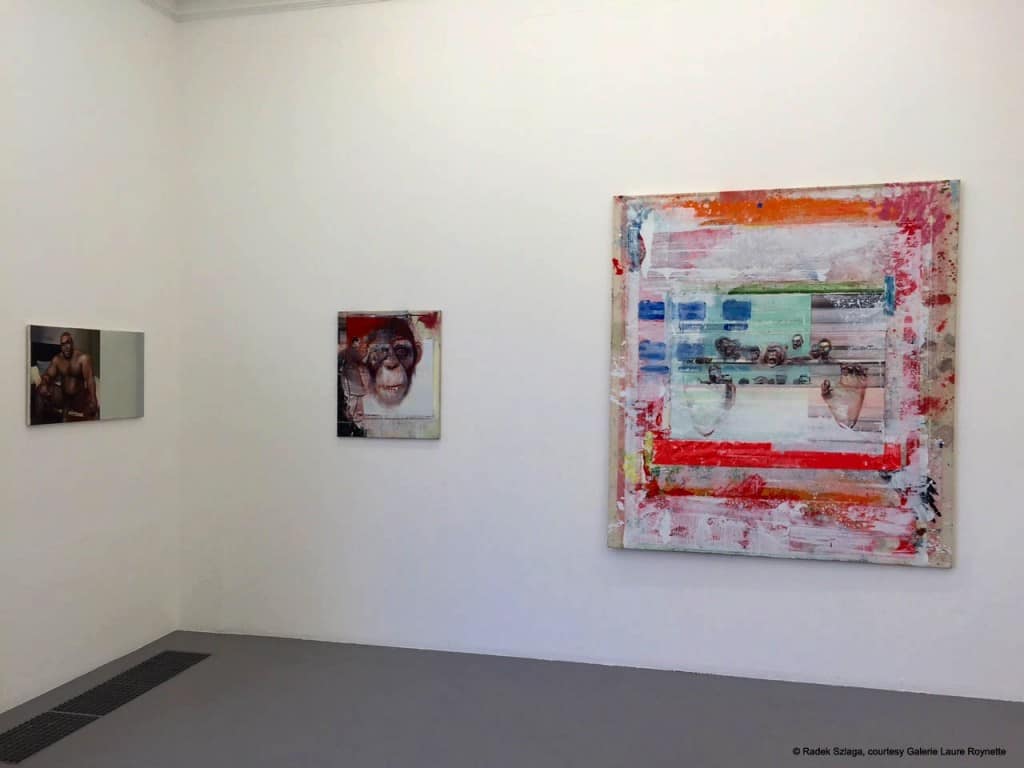Laure Roynette Galerie in Paris recently hosted a project by Sandra Mulliez, founder of the SAM art project. The Heart, an exhibition featuring the work of Polish painter Radek Szlaga is the second collaboration to take place between the SAM art foundation and an artist of Polish origins. The first show by Angelika Markul, which was also reviewed by Contemporary Lynx, resulted in a complex presentation at the Palais de Tokyo in Spring 2014.

Radek SZLAGA, The Heart, exhibition view, courtesy Galerie Laure Roynette
Having for his disposal the entire Laure Roynette gallery space, Szlaga decided to exhibit a selection of paintings from his ongoing project. The artist is well known both in Poland and in the US, and has recently gained the attention of the European art scene. Remaining faithful to his rich and eclectic style of painting, which once led him to a long-term research project on the personage of Ted Kaczyński (also known as Unabomber), Szlaga continues to experiment with image. Kaczyński’s biography fuelled Szlaga’s artwork for a few years, fruiting various multimedia installations. His spectacular show in 2012 at The Centre for Contemporary Art, Ujazdowski Castle in Warsaw consisted of dozens of canvases covered with layers of projected images, juxtaposed with sculptures and installations from this period of his practice. Szlaga continued experimenting with powerful narration, seen in his exhibition space at the PERFORMA 13 festival in New York. There, together with fellow artist Konrad Smoleński, Szlaga revealed a series of musical and visual performances titled TRIBUTE TO ERRORS AND LEFTOVERS. This installation reached a certain limit of hypertextuality and excess. The viewer as well as the author was left overwhelmed by the intensive stimulation, which may have drifted away from the core of Szlaga’s visual practice. Now it seems that the exhibition space supersaturated with light, sound, and powerful visual narration has become less interesting for Szlaga. Instead he has turned to the core of the painting, seeking out the force in the singular voice of the canvas, which speaks for itself without amplifying the physical spatial context.

Radek SZLAGA, The Heart, exhibition view, courtesy Galerie Laure Roynette

Radek SZLAGA, The Heart, exhibition view, courtesy Galerie Laure Roynette
The exhibition The Heart is a scant excerpt of an elaborate project initiated by the artist’s consciousness a long time ago as a direct result of his personal situation. As described by Szlaga himself, “Constantly in motion” reflects his regular travels in Poland and to the US where his family lives.
In The Heart, Szlaga uncovers the feeling of alienation towards a given location, as well as the continual process of rethinking his cultural surroundings, strongly influenced by conflating social and cultural circumstances in the two countries which constitute his life. The origins of the project lie in Joseph Conrad’s Heart of Darkness (1899).
Szlaga draws from a few significant questions posed by this Polish writer for this series of works, including the notion of time and space – a constant journey, which enables one to stand back objectively, and critically understand culture and history. He also deals with the difficult subject of the extensive history of colonialism, and the intolerance it caused. As a painter, Szlaga contorts the image, which through its figuration function and juxtaposition with other images, is able to build complex narratives.
The paintings shown in Paris are representative of the whole project and Szlaga’s artistic approach. Anus Mundi (oil on canvas, 2013) comprises of 4 separate pieces of canvas, repeated onto each other. Four images of map of Africa explain the title, the fourth image being a green space. It is an appropriation of Wilhem Sasnal’s painting Forrest (oil on canvas, 2002), which recreates an irreplaceably intensive green forest through simple artistic gesture and a calculated colour choice.
Szlaga also appropriates the artwork of other artists, in the same manner as colonialists appropriated new lands, or contemporary culture incorporates Conrad’s novel. His stencil paintings take us back to Christopher Wool’s black and white paintings consisting of quotations, such as from Fancis Ford Coppola’s Apocalypse Now (1979). Szlaga’s compositions also recall Peter Doig’s style of working with found images, another form of appropriation. Finally he reuses his own canvases, which are cut or partly repainted.
Szlaga was struck by a sentence quoted from Kurtz: “Exterminate all the brutes”. These words have also been a fundamental source of inspiration for the book of the same title by Sven Lindqvist (1999), where the writer draws on his research in visual motifs connected with the history of colonisation. With realistic precision Szlaga transfers onto canvas photographs of soldiers of the English empire hunting wild animals or proudly posing with caught prey (Hunters 3, 75 x 60 cm, oil on canvas, 2015). Szlaga wants the viewer to draw the same messages as him; his portrait of Charles Darwin sends directly back to the scientific discourses which accompanied imperialistic politics. In addition, the spectator is confronted with a few paintings explaining the morphology of words initially part of other artist series – a personal alphabet seeking out similarities, and the slight yet fundamental differences between language and human expression. Through exploring these motifs, the artist directly indicates how the history and public discourse surrounding colonialism deeply permeated culture and remains vibrant, as seen in his stereotypical representation of African-American communities living in Detroit social ghettos.
Szlaga’s strong stance towards this uneasy history provocatively raises more questions. The show in Paris shed light on only a small amount of the painter’s images, which continue to grow in numbers. Some of them disappear in an artistic process of reworking not only motives but their actual realisation. Szlaga, in a similar manner to Kurtz, stays in motion and continues his travel but with one clear difference: Conrad’s character heads into an eponymous dark destination of his personal journey, while Szlaga is on his way into the heart of image and painting. I am looking forward to observing a continuation of this pathway, in order to see whether it is possible to reach this set target.

Radek SZLAGA, The Heart, exhibition view, courtesy Galerie Laure Roynette

Radek SZLAGA, The Heart, exhibition view, courtesy Galerie Laure Roynette

Radek SZLAGA, The Heart, exhibition view, courtesy Galerie Laure Roynette

Radek SZLAGA, The Heart, exhibition view, courtesy Galerie Laure Roynette

Radek SZLAGA, Republics, 80x120cm, oil, 2014, The Heart, exhibition view, courtesy Galerie Laure Roynette
THE HEART – Radek Szlaga
Carte Blanche to Sandra Mulliez
GALERIE LAURE ROYNETTE
20 rue de Thorigny
75003 Paris
www.laureroynette.com
April 17th – May 23rd
opening April 16th, 6.00 PM









